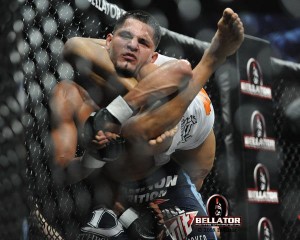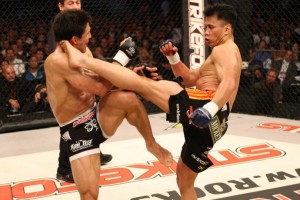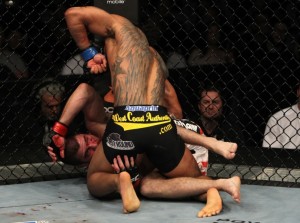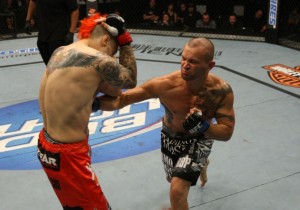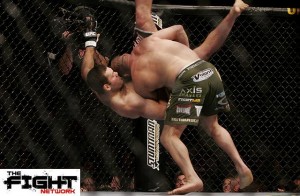Five Disciplines of MMA
By Lisa Teichner
There are many martial arts disciplines and technically any combination of them would be considered mixed martial arts. However, there are varying opinions as to precisely which combination of disciplines make for the most effective and successful MMA fighter.
Let’s start with five of the most common disciplines you will see when you watch a televised MMA event such as the Ultimate Fighting Championship, Strikeforce or Bellator. We mention these organizations because they are considered the top of the MMA food chain. They actually pay the fighters to fight (some fighters earn up to six figure purses), most consider the majority of the belt holders or belt contenders to be the best fighters in the world and the shows promoted by these companies can be a vehicle to propel an otherwise unknown fighter to super stardom in the blink of an eye.
Discipline Number 1 – Brazilian Jiu-Jitsu
Brazilian Jiu-Jitsu, which was adapted from Japanese Jiu-Jitsu into its contemporary form by the Gracie family beginning in the early to mid 1900’s is a grappling or ground fighting system which includes submissions such as chokes, arm locks and foot locks. The basic idea of Brazilian Jiu-Jitsu (BJJ) is to effectively utilize the principles of leverage to disable your opponent without doing permanent damage or harm. There has also been great emphasis on the fact that with proper technique; a smaller, weaker person can successfully defend themselves against a larger, stronger opponent. Rorion Gracie brought Brazilian Jiu-Jitsu to the United States in the late ‘70s and through his establishment of the Ultimate Fighting Championship in 1993, the “soft/gentle art” was revealed to the masses. If an MMA fighter has not trained in the discipline of Brazilian Jiu-Jitsu, he may find himself in a very disadvantaged position when a fight goes to the ground, which, according to combat studies, the majority of fights do. BJJ techniques we have commonly seen end fights include the triangle choke, rear naked choke, key lock and guillotine.
Discipline Number 2 – Muay-Thai
Muay-Thai, or Thai Boxing, is the national sport of Thailand and a stand-up discipline which involves striking using eight points of contact rather than traditional boxing which uses two (fists only). Muay Thai strikes include punching, kicking, elbows and knees. It is highly focused on striking from the clinch position. A few highly effective Muay Thai strikes that can end fights in a single blow are the leg kick, knee to the liver and high kick to the head.
Discipline Number 3 – Wrestling
Wrestling is one of the oldest forms of combat being the number one competition sport featured in the Olympic Games in ancient Greece. The most common forms today are Greco-Roman and Freestyle. Of course, the “professional” wrestling world of WWE is incredibly popular as a form of public entertainment and admittedly, sometimes these types of theatrics do carry over into MMA (who can forget Dennis Hallman’s recent bikini bottom incident at UFC 133) but there is little tolerance by MMA fans for anything other than actual fighting. Wrestling is predominantly a grappling sport in which the goal is to achieve and maintain a superior position and submit or “pin” your opponent to win a match. Wrestlers, who greatly rely on power and strength, are also well known for their excellent takedowns (i.e. single leg, double leg, clinch) as well as their ability to control an opponent on the ground. In an MMA fight, takedowns, ground control and aggressiveness are often given great consideration by the judges and can mean the difference in winning a decision. Professional MMA fighters with a strong wrestling background take pride in their “ground and pound” skills and their strategy will often involve taking down an opponent, sitting inside the opponent’s guard and throwing strikes.
Discipline Number 4- Boxing
Boxing as a combat form was also practiced in ancient Greece but has since been adapted into its contemporary, Western form. Since boxers only focus on striking with their hands, they have the best punches in the business, so to speak. The main strikes in boxing are the jab, cross, hook, uppercut and body shots (liver/45, kidney). In an MMA fight, a boxer’s skills will be revealed when both fighters are standing “in the pocket.” Many MMA fans feel that boxers make for exciting fights because they will hit and be hit, a lot. One of the most important adjustments a boxer must make when fighting MMA is his stance. He cannot afford to leave his front leg wide as he will be vulnerable to takedowns from wrestlers and leg kicks from Muay Thai practitioners. This can be very difficult because the boxer’s power comes from his stance. However, the good news for the boxer is that standard MMA gloves weigh only four ounces, so one punch can do great damage, whereas a typical pro boxing glove weighs 10 ounces and can take many rounds to accumulate an equal amount of damage.
Discipline Number 5 – MMA
Now don’t be fooled into thinking that if you go and study all of the individual disciplines mentioned above, you will end up UFC Champion in your weight class. Yes, studying different forms of fighting such as these will greatly improve your game but you must also put it all together in actual MMA sparring. There are thousands of nontraditional and untaught moves that happen during transitions from stand up to the ground or technique to technique and the only way you can learn what to do during these moments is through practicing MMA as its own discipline. Meaning, if you want to be a professional MMA fighter, any of the individual disciplines above might not be of service to you if you don’t learn how to “put it all together.”
The last discipline we must touch on (which we could effectively call number six) involves your own discipline. Your discipline to train, to eat right, to personal improvement, to develop and maintain a positive mindset.
Can you win a belt without training hard, improving your techniques and yourself as a person? Sure you can, many fighters have. But it is when you are able to master these disciplines that you can truly become a champion.



